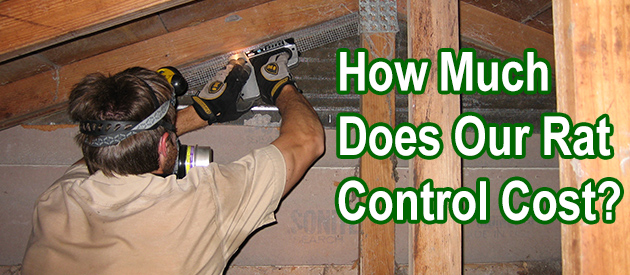Wake County, Raleigh Rat Control Situation:
How can I tell if I have rats or mice hanging out in my walls/attic? We haven't found any signs of anything getting into the main part of the house, but every once in a while we hear them scurrying around in one spot. We only hear them in the evening, and we haven't heard them very often (tonight is the first time I have noticed them in two weeks, but I'm also not home every evening). First we thought it was mice, but I am starting to worry that they might be rodents nesting for the winter. I checked outside and couldn't find any visible entry points, nor any footprints on the roof. I also looked under the roof overhang on that side of the house and there are no holes there. I can't tell if I am hearing squirrel chirping or mouse squeaking--it's almost a squeak-like chirp (real helpful, I know). If we can't find any holes for them to get in, it makes me think mice, but if we haven't seen any signs of them in the house and only hear them in one spot, it makes me think squirrels. Whatever it is has had access to this spot for quite some time, so if they are rats, I think we need to act ASAP, as per the damage reports I've seen on websites. Any and all advice you have to diagnose what we are dealing with would be greatly appreciated! Thanks for your help! - Kristin
My response: Sounds like mouse or rat activity to me. Squirrels are active in the daytime, and people usually hear a lot of morning noise. If you inspect the attic, you can tell by the droppings left behind.
Raleigh Rat Control Tip of The Week
City Subways And The Presence Of Rats
Rats, like pigeons, badgers, and foxes thrive in urban environments, even moving to these places. Cities are full of garbage dumps, abandoned lands, and sewers that can provide a cozy burrow for rats to live in and raise their families. Human beings have provided the perfect conditions for the well-being of this species.
Sewers And Rats
Sewers can provide everything needed for an exponential multiplication of rodents. The problem is that the more rats there are, the more they need food, so to get it they will be severely aggressive towards each other. This aggressiveness and the search for new food sources can cause serious damage to the city.
Rats Are The Real Infection
These rodents are known for carrying bacteria that cause infectious diseases leading humans to death. Something similar occurs with rats when they spread through sewers, subways, garbage dumps, and train tracks.
Rats survive thanks to the mountains of garbage in the city and play a vital role in reducing this waste. However, wiring or holes and infrastructure problems can be just some of the catastrophic consequences for the city's subway system.
Super-rats
Humans love junk food and in big cities, high-calorie garbage has given the rats that eat it the energy they need to grow exorbitantly even creating resistance to some rat poisons.
The well-being of citizens begins with professional pest control combined with a mind-set of not throwing garbage into the environment. Briefly, if there is neither food nor garbage, there are no rats. The fewer rats there are in places like the subway, the fewer rats will be able to reach homes. The more we take care of the city, the fewer health problems or economic damage there will be.


